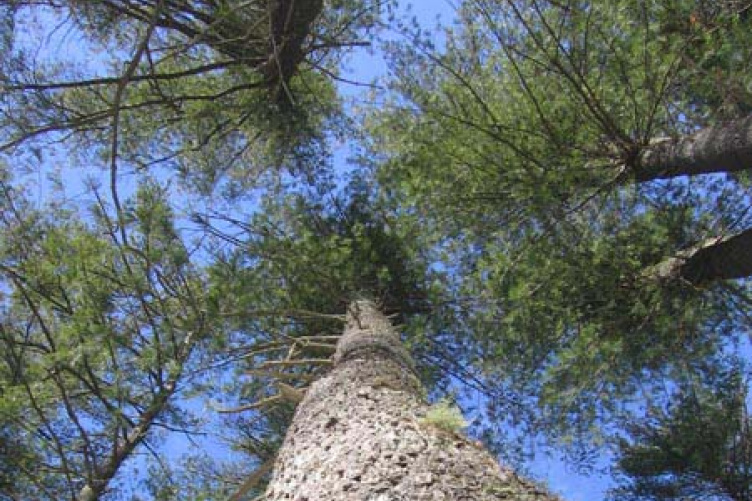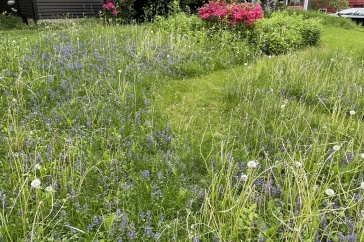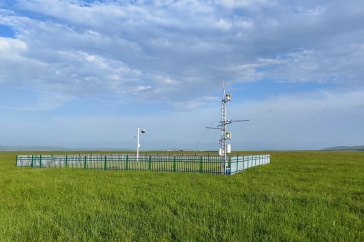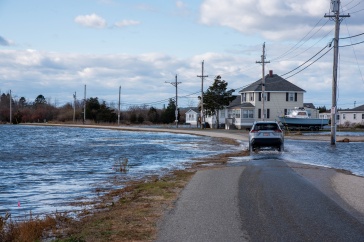
One-hundred-foot-tall white pine by the Soucook River in Loudon, NH. Photo courtesy of Phil Browne.
Until this past February, Barry Rock had no idea that over twenty years of scientific data gathered by students and teachers in UNH’s inquiry-based Forest Watch program were a mirror image of crucial environmental findings recently released by state officials.
Since its founding in 1991, the program’s research on white pines around the New England region, which is conducted by K-12 students and their teachers, in conjunction with UNH researchers, has shown a steady increase in the health of this vital forest species.
While the Forest Watch analysis showed the trees’ vigor to be tied to improved air quality, it wasn’t until Rock saw ozone, or smog, records the state’s Department of Environmental Services-Air Resources Division had collected since the late 1980s that the big picture came into focus: steadily declining ozone levels since 1991 fit the year-to-year improvements in white pine health like a glove.
“It was just coincidence that Forest Watch began in 1991, the year of our highest ozone levels as it turns out, but now we know there’s no coincidence between lower ozone and improved white pine health,” says Rock, the founding director of Forest Watch and now professor emeritus in the Institute for the Study of Earth, Oceans, and Space (EOS) Earth Systems Research Center and the department of natural resources.
Every year, Forest Watch students and teachers gather white pine needles from trees near their schools, measure the length of the needles and the amount of area occupied by spots caused by ozone damage, and calculate the percentage area of needle damage. Rock and his researchers also gather comparative data on rainfall, temperature, and insects to see if these might factor into tree health or damage.
Pinus strobus, or the eastern white pine, is a known bio-indicator species for exposure to ground-level ozone—as opposed to the “good” ozone in Earth’s upper atmosphere that protects us from ultraviolet radiation.
In addition to damage to new needles, older needles are lost as well when smog levels are high. Thus, during poor air quality years, white pine growth is impaired and results in reduced economic and environmental value of the trees. Ozone reduces a tree's ability to convert sunlight into energy and food and accelerates aging in older foliage.
In 1990, the federal Clean Air Act Amendments took effect and eventually led to the enactment of the state’s National Ambient Air Quality Standards in 1997, which Rock characterizes as “the clincher” with respect to falling ozone levels and needles with increased, vigorous growth for longer periods of time.
The manufacture of ground-level ozone requires nitrogen oxides that come out of the tailpipes of cars, as well as both manmade and natural volatile organic compounds from, for example, paint thinners and the active growth of plants. In the presence of sunlight and elevated temperatures, these compounds generate the smog that Forest Watch has tracked for over two decades.
Rock notes that, together with federal regulations, the state has been implementing a number of policies that reduce both nitrogen oxides and volatile organic compounds emitted into the atmosphere.
“I’ve always maintained that policy changes drive innovation, and here’s a great example of federal and state regulations aimed at reducing pollutants, including recent reduced carbon dioxide emission levels, EPA-required improved mileage standards, and more hybrid vehicles on the road, etcetera, having a dramatic, positive impact on air quality and white pine health,” Rock says. “And this is a key message to get out to the public because it comes at a time when there is a growing effort in Congress to trim back on EPA regulations, which are considered by some to be too restrictive on business and industry.”
Originally published by:
Spheres Online, Institute for the Study of Earth, Oceans, and Space
-
Written By:
Staff writer | Communications and Public Affairs



















































